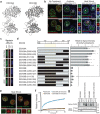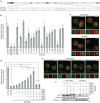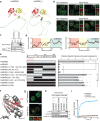Protein thermal sensing regulates physiological amyloid aggregation
- PMID: 38336721
- PMCID: PMC10858206
- DOI: 10.1038/s41467-024-45536-0
Protein thermal sensing regulates physiological amyloid aggregation
Abstract
To survive, cells must respond to changing environmental conditions. One way that eukaryotic cells react to harsh stimuli is by forming physiological, RNA-seeded subnuclear condensates, termed amyloid bodies (A-bodies). The molecular constituents of A-bodies induced by different stressors vary significantly, suggesting this pathway can tailor the cellular response by selectively aggregating a subset of proteins under a given condition. Here, we identify critical structural elements that regulate heat shock-specific amyloid aggregation. Our data demonstrates that manipulating structural pockets in constituent proteins can either induce or restrict their A-body targeting at elevated temperatures. We propose a model where selective aggregation within A-bodies is mediated by the thermal stability of a protein, with temperature-sensitive structural regions acting as an intrinsic form of post-translational regulation. This system would provide cells with a rapid and stress-specific response mechanism, to tightly control physiological amyloid aggregation or other cellular stress response pathways.
© 2024. The Author(s).
Conflict of interest statement
The authors declare no competing interests.
Figures








Similar articles
-
Stress-specific aggregation of proteins in the amyloid bodies.FEBS Lett. 2019 Nov;593(22):3162-3172. doi: 10.1002/1873-3468.13597. Epub 2019 Sep 20. FEBS Lett. 2019. PMID: 31512750
-
Adaptation to Stressors by Systemic Protein Amyloidogenesis.Dev Cell. 2016 Oct 24;39(2):155-168. doi: 10.1016/j.devcel.2016.09.002. Epub 2016 Oct 6. Dev Cell. 2016. PMID: 27720612 Free PMC article.
-
Escherichia coli small heat shock protein IbpA is an aggregation-sensor that self-regulates its own expression at posttranscriptional levels.Mol Microbiol. 2021 Jan;115(1):142-156. doi: 10.1111/mmi.14606. Epub 2020 Oct 14. Mol Microbiol. 2021. PMID: 32959419
-
Reversible protein aggregation as cytoprotective mechanism against heat stress.Curr Genet. 2021 Dec;67(6):849-855. doi: 10.1007/s00294-021-01191-2. Epub 2021 Jun 6. Curr Genet. 2021. PMID: 34091720 Free PMC article. Review.
-
Protein misfolding, aggregation and mechanism of amyloid cytotoxicity: An overview and therapeutic strategies to inhibit aggregation.Int J Biol Macromol. 2019 Aug 1;134:1022-1037. doi: 10.1016/j.ijbiomac.2019.05.109. Epub 2019 May 22. Int J Biol Macromol. 2019. PMID: 31128177 Review.
Cited by
-
Stress-Induced Evolution of the Nucleolus: The Role of Ribosomal Intergenic Spacer (rIGS) Transcripts.Biomolecules. 2024 Oct 20;14(10):1333. doi: 10.3390/biom14101333. Biomolecules. 2024. PMID: 39456266 Free PMC article. Review.
References
MeSH terms
Substances
Grants and funding
LinkOut - more resources
Full Text Sources

